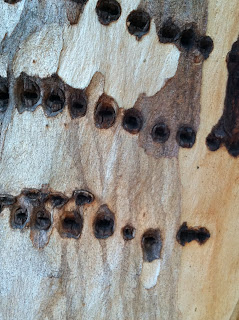In 2008, the U.S. Environmental Protection Agency (EPA)
released new safety measures intended to reduce children’s exposures to
rodenticides in the home and reduce risks to wildlife. These measures were to
be implemented by 2011 but not all companies complied with the measures. In response, the EPA recently took action to
remove 12 rodenticide products from the market but pending litigation has
stopped the ban for now.
So what’s all the concern since rodenticides kill
rodents? Yes, rodenticides contain
active ingredients that kill rodents in varying ways. However, they can also
kill or seriously compromise the health of non-target wildlife, children and
pets. The Red-tailed Hawk, Great-horned Owl, Bobcat, Mountain Lion, Gray Fox,
Red Fox, Black Bear, and Turkey Vulture, to name a few, are species that can be
negatively impacted by rodenticides. In
California, the Department of Pesticide Regulation (DPR) has determined that impacts
to non-target wildlife by second-generation anticoagulant rodenticides are a
statewide issue and is proposing new regulatory action (No. 13-002) to
designate those rodenticides as restricted materials and limit the placement of aboveground
baits.
 So what are rodenticides? Rodenticides are pesticides that
contain active ingredients that can be classified into three types: 1) acute
toxicants (AT’s), 2) first-generation anticoagulant rodenticides (FGAR’s) and
3) second-generation anticoagulant rodenticides (SGAR’s), and they are placed indoors
or outdoors in tablet, pellet and/or paraffin block form. They can even be
contained in bait stations. Acute toxicants work in several ways such as
impairing nerve cell action or causing cell death. With anticoagulant rodenticides, the animals’
blood loses its clotting ability and capillaries are damaged, causing the
individual to die from internal bleeding. With FGAR’s, animals must consume the
rodenticide several times to accumulate a lethal amount of toxin in their body
and some animals became resistant to the active ingredient(s). Therefore, SGAR’s were developed that are
more toxic and designed so that lethal concentrations are consumed in just one feeding. However, it takes several days for the rodent
to die during which time it can return to feed on the rodenticide, building up
extremely high concentrations in its tissues.
If it becomes prey for predators, those high concentrations of
rodenticides are passed to the predator and can be lethal or compromise the
non-target animals' health.
So what are rodenticides? Rodenticides are pesticides that
contain active ingredients that can be classified into three types: 1) acute
toxicants (AT’s), 2) first-generation anticoagulant rodenticides (FGAR’s) and
3) second-generation anticoagulant rodenticides (SGAR’s), and they are placed indoors
or outdoors in tablet, pellet and/or paraffin block form. They can even be
contained in bait stations. Acute toxicants work in several ways such as
impairing nerve cell action or causing cell death. With anticoagulant rodenticides, the animals’
blood loses its clotting ability and capillaries are damaged, causing the
individual to die from internal bleeding. With FGAR’s, animals must consume the
rodenticide several times to accumulate a lethal amount of toxin in their body
and some animals became resistant to the active ingredient(s). Therefore, SGAR’s were developed that are
more toxic and designed so that lethal concentrations are consumed in just one feeding. However, it takes several days for the rodent
to die during which time it can return to feed on the rodenticide, building up
extremely high concentrations in its tissues.
If it becomes prey for predators, those high concentrations of
rodenticides are passed to the predator and can be lethal or compromise the
non-target animals' health. 
 Aside from direct death due to anticoagulant toxicity, wildlife
exposure to anticoagulant rodenticides can weaken an animals' immune
system, making it vulnerable to other diseases/infections such as mange, a
disease caused by a parasitic mite. Mange causes intense itching, hair loss and
eventually thickening of the skin if the host animal is not healthy enough to
fight the infestation. Eventually, the
skin may tear leading to bacterial infections and death. A study conducted in the Santa Monica
Mountains (Riley et al 2007) determined that two (2) mountain lions died as a
direct result of anticoagulant toxicity, 90% of dead bobcats tested positive
for anticoagulants and there was a high level of association in bobcats between
severe mange and anticoagulant exposure. In the Puente Hills, one bobcat tested
positive for anticoagulants rodenticides, at least one other bobcat died with severe
mange while a third with severe mange was captured, treated and re-released.
Aside from direct death due to anticoagulant toxicity, wildlife
exposure to anticoagulant rodenticides can weaken an animals' immune
system, making it vulnerable to other diseases/infections such as mange, a
disease caused by a parasitic mite. Mange causes intense itching, hair loss and
eventually thickening of the skin if the host animal is not healthy enough to
fight the infestation. Eventually, the
skin may tear leading to bacterial infections and death. A study conducted in the Santa Monica
Mountains (Riley et al 2007) determined that two (2) mountain lions died as a
direct result of anticoagulant toxicity, 90% of dead bobcats tested positive
for anticoagulants and there was a high level of association in bobcats between
severe mange and anticoagulant exposure. In the Puente Hills, one bobcat tested
positive for anticoagulants rodenticides, at least one other bobcat died with severe
mange while a third with severe mange was captured, treated and re-released.
Currently, numerous cities and counties are showing support
for the EPA and DPR by passing resolutions opposing the sale, purchase and use
of certain rat and mouse poison products that pose an unacceptable risk to
children, pets and wildlife. The Board
of Directors for the Puente Hills Habitat Preservation Authority passed one
such resolution in August 2013 as did the City of Whittier in July 2013. You can have your voice be heard by
submitting comments to the California DPR on their Notice of Proposed
Regulatory Action No. 13-002 by October 4, 2013, before 5:00 p.m. More information can
be found at:

